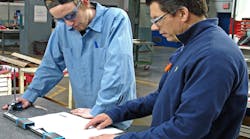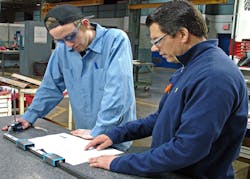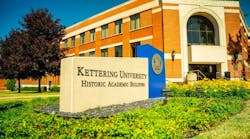Gilman Precision finds a good source for new, young employees
Consider a high school sophomore. We’ll call him Jack. Jack hates school. He’s bored and restless. He’s not learning anything that interests him. He wants to work with his hands, not spend all his time in the classroom learning about dead Europeans and poetry he doesn’t like or understand. Math is okay, but it’s not enough. His grades aren’t what they should be, and he’s not interested in college anyway. He’s at a vulnerable age when he could make some very bad decisions that will put him on the wrong track for the rest of his life.
What do we do about a problem like Jack?
If Jack is fortunate enough to live in eastern Wisconsin and in one of the over 50 school districts that are part of the program developed by GPS Education Partners, we might just let him drop out of high school. That sounds counterintuitive, but over the past 15 years, more than 300 young people like Jack have done that and benefited instead from the GPS intern program.
How It Works
The short explanation is that qualifying juniors and seniors in participating school districts enter a program that gives them two or three hours of classroom learning every day, Monday through Friday, followed by five or six hours of working at their designated intern location—the facilities of one of the more than 100 manufacturing operations that are “business partners” of GPS.
Their academics are taught by certified teachers at one of the manufacturing facilities in the program. In the work portion of their day, they are assigned to a mentor who will guide them in learning the basic skills of their job, and over the course of the program, they will be exposed to a variety of factory functions.
Mike Weiland, COO at Gilman Precision, Grafton, Wisconsin, says, “Our last intern we took through shipping and receiving, inventory, pulling parts for jobs. We have also gotten them into deburring functions and grinding work.”
In the course of 21 months, the students gain industry credentials, employability skills and transferable post-secondary college credits. The GPS program boasts a 90% graduation rate and an attendance rate of 95%.
Qualifying Isn’t Easy
If our hypothetical Jack thinks the program is a get-out-of-jail free card, buying him a release from discipline and learning, he’s in for rude awakening. First, he really has to want the program, and just being bored with school does not gain him entry.
“The application process is pretty extensive and intensive,” says Jan Druetzler-Katz, the program coordinator for GPS Education Partners. “Students need three recommendations. We need to see their school records. They have to face an interview with three people—a teacher, an administrator and an h.r. person from one of our business partners. They take a tour of one of our education centers. And our program is drug-free. If they fail a drug test, they don’t get in. They need to understand what it is they’re applying for.”
There’s also a family commitment involved. “We know that students are more successful when families are involved. It’s a big-time commitment for the family,” adds Druetzler-Katz.
Jack’s family will get a monthly report on how he is doing in the academic and youth apprenticeship portions of the program. Parents can also engage with the business mentors through Parent/Mentor dinners as well as Parent/Teacher conferences that are held at the student placements, giving them a chance to see where their child is working and what they are doing.
The family also has access to additional resources through GPS’ Parent Engagement Program, including parenting workshops, financial literacy workshops and an open forum for dialogue with teachers and employers, and a dedicated online Parent Portal on the CPS website that provides them with additional information and resources.
Welcome to the Real World of Work
Once accepted, students have to show up for their classroom work beginning at 7:00 a.m. When their classroom work is over, they have to get to the company they are assigned to—on their own. Since many are too young to drive or don’t have a car, it’s up to them to figure out either public transportation or find a family member willing to commit to getting them from the classroom to work. Oh, and they follow a real-world work schedule. No summer vacation, no two-week Christmas holiday, no spring break.
Gilman Precision production supervisor Chris Hannert walks intern Jash Casper through a drawing.
Image courtesy of Gilman Precision
On the upside there is no tuition, only fees similar to those at a public high school. Student get paid minimum wage for work time, and if they perform well in their academics, they can also earn up to 10 hours a week of classroom pay. They also have a chance to qualify for performance-based raises. Just as important, if not more so, is that by the time they complete the program, they will have passed the Manufacturing Skill Standards Council (www.msscusa.org) test, giving them a portable credential as a certified production technician.This last benefit is also important to potential employers. “Last year one of our business partners hired three ladies, two for CNC machine operation and one for welding. They did go back to school for additional training to learn programming and other things, but from day one, they were ready to operate the machines,” says Druetzler-Katz.
Josh Casper, Gilman Precision’s current intern, sums up his experience in the program. “Regular schooling just wasn’t for me. I learned this after my guidance counselor suggested I look into GPS and consider a career in manufacturing, even though before working at Gilman I knew absolutely nothing about the industry. The two hours I spend in the classroom are directly applied to what I do at work. I continue to learn daily by working in all areas of the factory, including grinding, assembly and inspection. I couldn’t have asked for a better group of people to work with.”
But do the GPS students miss the traditional high school experience at all—the games, the prom, their friends, anything? Weiland says, “During the exit interview with our first intern, I asked him what he missed about high school. He said, ‘Absolutely nothing.’”
Participating business partners are vetted as well as potential students. “We sit down with employers and talk about how to provide a quality experience,” says Druetzler-Katz. “It’s an investment in time. They have to have people who will mentor the students. They’re green kids, and they need people who can train them. If a business thinks, ‘Oh, I can get these kids for cheap,’ they’re going to be disappointed.”
But she adds, “People have usually thought this through [before they decide to participate], and they can offer opportunities for the students. Usually, it’s a question of wanting to be involved and helping the kids.”
Company Benefits
Participation may start out as a community service activity, but business partners learn that it can be a case of doing well by doing good. For one thing, it’s a way of addressing the problem of the rapidly retiring work force.
“Brain drain is definitely a concern of ours,” says Gilman’s Weiland. “Here everyone has 25 or 26 years of experience. At some point, we’re going to have a bunch of people leaving. My biggest issue is that we’re going to have to find a lot of people at one time, and there isn’t a plethora of people to look at, especially in more technical areas.”
He goes on to say, “This program is really steering people in that direction. Not everyone is made for college. You don’t necessarily have to go to college [to get a good job]. Today kids are coming out of college and can’t find a job, but a technically skilled person can be earning and making up to $30.00 an hour after some experience."
And even if a particular company isn’t facing an imminent brain drain, having first access to a pool of qualified new hires is a benefit in itself.
Druetzler-Katz says, “Companies who participate are pretty satisfied. Some have been business partners for more than 10 years. Our business partners hire our students, but that’s not a requirement of the program. They do that on their own. They know these students are work-ready and maybe even above entry level.”Weiland adds, “We’re working with our second intern now, but the first one, if I had a vacancy, I would consider hiring him.”

Leaders relevant to this article:




